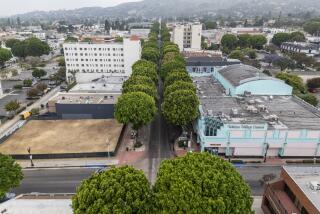Oaxaca Plaza’s Trees Inspire Devotion, Defense
- Share via
MEXICO CITY — Two years ago, artists and architects banded together to stave off McDonald’s from opening on the picturesque main square in the southern city of Oaxaca.
Now some of those same activists are under attack themselves over their plan to evict another foreign invader -- the towering India laurel trees that shade the historic plaza. Opponents say the idea is political correctness run amok.
“This is almost dogmatic,” said painter Francisco Verastegui, who joined the fight to oppose McDonald’s but is leading the battle against the renovation project. “They’re nonnative species, so we have to get rid of them? That’s like botanical racism.”
His foe is a group of artists and architects who launched -- with little public consultation -- a vast remodeling project at the square that included talk of eventually replacing “foreign” laurels with native trees.
Planted in the 1870s, the broad-limbed, dense laurels have shaded generations who come to the plaza to escape Oaxaca’s hot, dry climate.
Bulldozers felled one of the laurels as workers were ripping up pavement in the square in late April.
The project’s planners called that an accident, saying they meant to replace the 11 laurel trees in the square only gradually, as they die off.
But many people in Oaxaca no longer trust the would-be renovators, and started a citizen’s committee to defend the trees and protest the lack of public consultation and cost of the plan, which includes repaving the entire square.
Founded in 1532, downtown Oaxaca is listed as a U.N. World Heritage site and a Mexican national historic area. The plaza is bordered by colonial-era arched walkways, government and church buildings, and open-air restaurants.
The trees shading the square are huge, some of them soaring 100 feet high. Designers of the renovation say they favor smaller trees, arguing that the current ones dwarf the surrounding buildings and block views.
But when workers showed up with chain saws to cut up the tree tipped over by the bulldozers, angry residents stood guard around the laurel and stopped them. The tree was later propped back up and may survive.
The fight -- which has left one of Mexico’s foremost tourist attractions ripped up and roped off -- has become so heated that federal authorities stepped in, ordering the city to slow down and open the plan to more public comment. Authorities also found that the project lacked permits required for such work in historic districts.
Even tourists, who provide the city’s lifeblood, say the new plan isn’t befitting in a city that fought off McDonald’s.
“I don’t see the sense in this. There was this battle two years ago to preserve the historical aspects, and now they want to knock down these trees. It’s illogical,” said Gustavo Vazquez, an assistant professor of media at UC Santa Cruz.
He visited Oaxaca in April and was angered by the ripped-up square and half-felled tree. He said the renovation -- intended to boost tourism -- could do the opposite.
“I would call on people to boycott the city if they knock down those trees,” Vazquez said. “If it wasn’t broken, why fix it?”
At the center of the battle is a small group led by artist Luis Zarate and architect Saul Alcantara, who drew up plans to change the plaza’s pavement and layout, and to “recover the spirituality of a native Oaxaca species” by replacing the laurels with native trees.
They say they never advocated cutting down the laurels, but rather want to plant native higo del valle or ahuehuete species wherever a laurel dies naturally.
“In the long term, our plan was to re-create the native vegetation of the Oaxaca valley,” Zarate said. “Our culture is very much tied to the plants of the region.”
Alcantara conceded that the plan was never submitted for public comment “on a mass scale,” but he defended the process, arguing that “people in the artistic world knew about it.”
The proponents have found themselves in what seems a replay of the McDonald’s battle they fought, but this time aimed at them.
Thousands of Oaxaca residents and visitors have attended demonstrations, painted placards and signed petitions against the renovation project.
“The square isn’t a canvas that belongs to any artist,” read one protest banner hung in the plaza.
More to Read
Sign up for Essential California
The most important California stories and recommendations in your inbox every morning.
You may occasionally receive promotional content from the Los Angeles Times.










